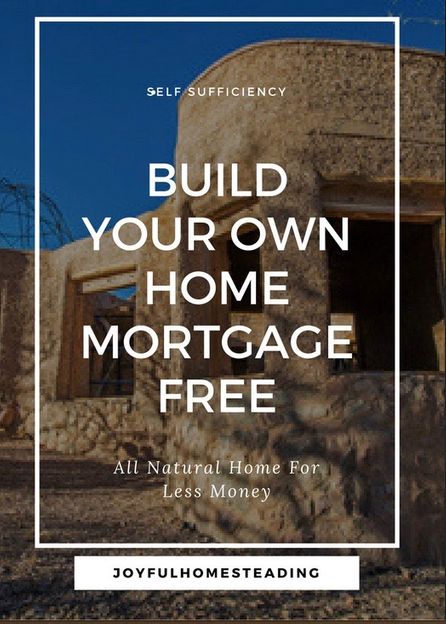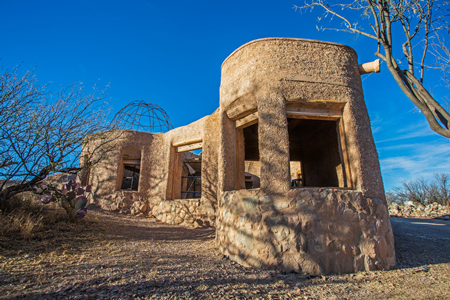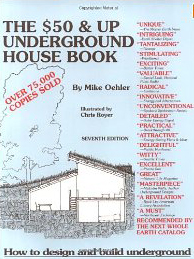Build Your Own Home
Build your own home using natural materials and you can save money, get debt free and be self-reliant much faster. But you must be willing to put in a lot more time and effort.

Get Land Cheap
Find a rural area a little further from town or earn your free land through homesteading it (some low-population areas still give away free land if you're willing to live there.) Just check with town hall to make sure they don't mind your building in a less conventional way.
Also, look for foreclosures. Sometimes you can get property at a great price.
Find Cheap, Temporary Shelter
It could take up to a year or more to build your own home. In the meantime you will need a place to live until your permanent home is built.
Look on Craigslist for a camper or put an ad in the classifieds asking if someone wants to get rid of their old mobile home. It can cost $1,000 or more to have a mobile home towed away. They may be happy to give it to you for free to avoid paying that cost.
Low Cost Ways to
Build Your Own Home
There are several low-cost ways to build.
Straw Bale Homes
Straw bales can be stacked, like bricks to form sturdy, load-bearing walls that can then be plastered over with either lime plaster or cob (see below). These beautiful homes well-insulated and save you a lot of money in energy costs.
If you do plan on building a straw bale home, be sure to chose land that isn't in a flood plain. Even though it is plastered over, straw bales that sit in water for any length of time will rot.
Also, you will need to be able to build the flooring and roofing yourself if you plan on saving money.
An Earth-Bermed Home
I love Mike Oehler's book, The $50 & Up Underground House Book, and the idea of building an underground home.
Don't think of it so much of a cellar, but rather a home built into a hill, covered on the top and on three sides with earth, but with plenty of windows to let in light. Underground or earth-bermed homes are warm in the winter, cool in the summer, and far sunnier than you can imagine.
We built an earth-sheltered storm cellar out of cedar blocks. My husband covered the building with a vinyl material that would keep out the moisture, and then we covered the three sides and the roof with earth.
This book is an excellent resources if you are considering building an underground home.
If you use wood, Oehler suggests wrapping your building with plastic sheeting to keep the moisture out.
Cordwood Buildings
If your land is wooded, you can build your own home using the cordwood method. Cordwood walls are built with cordwood and mortar. They are fairly easy to build - if you can lift a log, you can build it - and much less expensive to build. Cost of building this way can be as low as $10 per square foot.
Hardwood works better for a cordwood home because a softer wood will either contract or expand with humidity. If the wood expands, the mortar could split. If it contracts it could pull away from the mortar. Either way, outside air is let in. Also there is a risk of insect infestation, so you will need to treat your wood regularly.
On the plus side, once the walls are up, they're finished. You don't need to plaster over them. Also the walls will breathe, regulating the humidity in the home.
Earth Bag Construction
This is another low-cost way of building a home. You fill either sandbags or large, plastic bags with earth and stack them as you would bricks. Place a strip of barbed wire between rows to keep the bags in place. Once the bags are stacked on the barbed wire, they're in place almost permanently. It's hard to get them back off again, so place your bags carefully.
Since plastic will break down if exposed to sunlight, you will need to cover the walls with plaster to keep out the sunlight, but otherwise, the bags are durable and will last forever.
You can either make a cone-shaped roof out of the earth bags by gradually building inward or make a wood-roof construction.
Cob Construction
 |
I love the idea of cob construction even more than I do earth-sheltered homes. This is one of the most natural, low-cost ways to build your own home. It's also one of the most time-consuming, so if you are planning on building this way, budget in a lot of time.
Cob construction is a method where you mix together clay, sand, straw and water to make a natural mortar with which you build your house. You are, in fact, sculpting your home out of clay. It's one of the most durable ways to build a home. Cob homes, when properly cared for, can last for centuries.
It's also one of the most natural and breathable types of home. If you have asthma, a cob home is an excellent choice. Also the end product isn't any more dirty than any other type of home. The cob walls are covered with lime plaster.
But building this way is time consuming. Working diligently, you aren't likely to build higher than six inches per day. It will take you at least eight weeks to build a shed out of cob. A larger home will take much longer.








New! Comments
Have your say about what you just read! Leave me a comment in the box below.